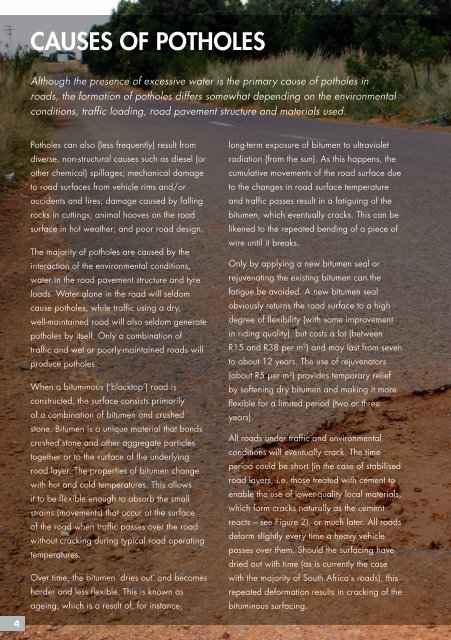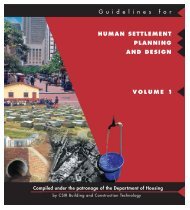POTHOLES: - CSIR
POTHOLES: - CSIR
POTHOLES: - CSIR
You also want an ePaper? Increase the reach of your titles
YUMPU automatically turns print PDFs into web optimized ePapers that Google loves.
CAUSES OF <strong>POTHOLES</strong><br />
Although the presence of excessive water is the primary cause of potholes in<br />
roads, the formation of potholes differs somewhat depending on the environmental<br />
conditions, traffic loading, road pavement structure and materials used.<br />
Potholes can also (less frequently) result from<br />
diverse, non-structural causes such as diesel (or<br />
other chemical) spillages; mechanical damage<br />
to road surfaces from vehicle rims and/or<br />
accidents and fires; damage caused by falling<br />
rocks in cuttings; animal hooves on the road<br />
surface in hot weather; and poor road design.<br />
The majority of potholes are caused by the<br />
interaction of the environmental conditions,<br />
water in the road pavement structure and tyre<br />
loads. Water alone in the road will seldom<br />
cause potholes, while traffic using a dry,<br />
well-maintained road will also seldom generate<br />
potholes by itself. Only a combination of<br />
traffic and wet or poorly-maintained roads will<br />
produce potholes.<br />
When a bituminous (‘blacktop’) road is<br />
constructed, the surface consists primarily<br />
of a combination of bitumen and crushed<br />
stone. Bitumen is a unique material that bonds<br />
crushed stone and other aggregate particles<br />
together or to the surface of the underlying<br />
road layer. The properties of bitumen change<br />
with hot and cold temperatures. This allows<br />
it to be flexible enough to absorb the small<br />
strains (movements) that occur at the surface<br />
of the road when traffic passes over the road<br />
without cracking during typical road operating<br />
temperatures.<br />
Over time, the bitumen ‘dries out’ and becomes<br />
harder and less flexible. This is known as<br />
ageing, which is a result of, for instance,<br />
long-term exposure of bitumen to ultraviolet<br />
radiation (from the sun). As this happens, the<br />
cumulative movements of the road surface due<br />
to the changes in road surface temperature<br />
and traffic passes result in a fatiguing of the<br />
bitumen, which eventually cracks. This can be<br />
likened to the repeated bending of a piece of<br />
wire until it breaks.<br />
Only by applying a new bitumen seal or<br />
rejuvenating the existing bitumen can the<br />
fatigue be avoided. A new bitumen seal<br />
obviously returns the road surface to a high<br />
degree of flexibility (with some improvement<br />
in riding quality), but costs a lot (between<br />
R15 and R38 per m 2 ) and may last from seven<br />
to about 12 years. The use of rejuvenators<br />
(about R5 per m 2 ) provides temporary relief<br />
by softening dry bitumen and making it more<br />
flexible for a limited period (two or three<br />
years).<br />
All roads under traffic and environmental<br />
conditions will eventually crack. The time<br />
period could be short (in the case of stabilised<br />
road layers, i.e. those treated with cement to<br />
enable the use of lower-quality local materials,<br />
which form cracks naturally as the cement<br />
reacts – see Figure 2), or much later. All roads<br />
deform slightly every time a heavy vehicle<br />
passes over them. Should the surfacing have<br />
dried out with time (as is currently the case<br />
with the majority of South Africa’s roads), this<br />
repeated deformation results in cracking of the<br />
bituminous surfacing.<br />
4

















